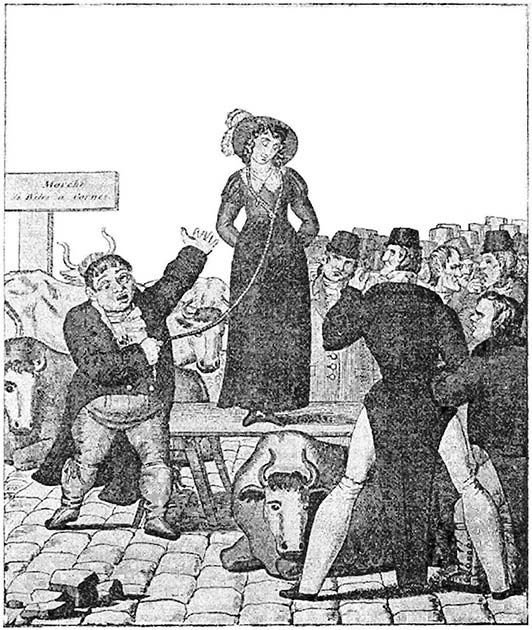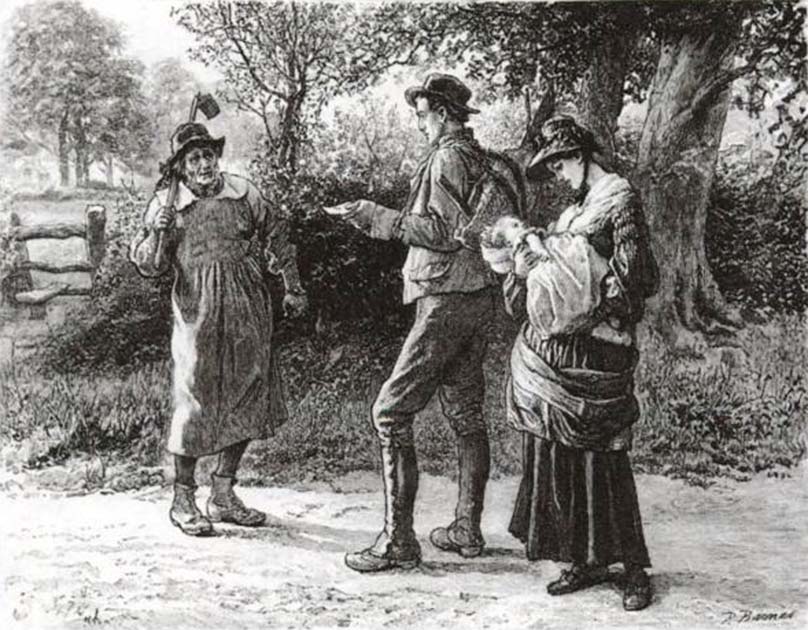Getting married is an exciting time in someone’s life, and you expect to be with your partner until death ends the union. Most people who get married do not plan on getting a divorce in the future, but in half of marriages, they will end in divorce.
Today, divorce involves a lengthy legal process with documents that need to be signed by a judge, assets to divide between the couple, and custody battles to be won. The process can be expensive, and a more simplistic option would be preferable for many couples.
In Victorian England, they dealt with things in a more brusque and straightforward manner. Before divorce was legal, one way to end an unsatisfactory marriage was to put your wife up for auction and then move on with life as a single man.
Why could men sell their wives, and was there any benefit to the practice?
Different Rules
Wife auctions (also referred to as wife selling) are precisely what they sound like: a man’s wife is shown to bidders like a dog in a dog show, and after being corralled around, another man could purchase the woman, thus ending the marriage. Wife auctions took place in Victorian England which is believed to have begun in the late 17th century.
Weddings and divorces were quite different than they were back in the 17th century, and until the Marriage Act of 1753, couples were not required to have a formal marriage ceremony performed by a clergyman, and there was no requirement to register the marriage or complete an official license verifying the wedding took place. Essentially, all a couple needed to do to get married was agree to the union, and both individuals had to be of legal age to marry.
The legal age for marriage in the Victorian age was 14 years old for boys and 12 years old for girls. But in many ways the law was positively feudal in its sexism: once the couple were married, the wife legally and actually became her husband’s property. During this period, women and their children were seen as property or possessions, just like cattle or a house.

Women were made subordinates of their spouses, which was a legal status applied to the situation known as coverture. Coverture meant that married women were not eligible or legally permitted to own property (even if the property was awarded to them through bequeathment).
- Orchidelirium: The Victorian Madness For Orchids At Any Price
- Bizarre Wedding Rituals Around the World
Being the property of her husband was seen as “favorable” to women by lawmakers, who were men. While marriage was a simple process, divorces were another story.
Divorce was prohibited in Victorian England until the Matrimonial Causes Act of 1857 was passed. The act gave newly developed Divorce Courts the power to litigate divorce cases.
Until the act was passed, there were few options for couples who wished to end their marriages. Marriage could be ended by being declared “separation mense et thoro,” which means “separation from bed and board,” annulment, private separation, and the extremely expensive bill of divorce.
Prior to the act being passed in 1857, divorce required an Act of Parliament, which included permission from a church, and these steps could cost around $15,000 in today’s currency. Unless couples were incredibly wealthy, divorce was essentially impossible.
So, the only options for many poor, unhappy married men in Victorian England were to either kill their spouse, or abandon them and run off to start a new life. Or sell them to another man.
How Wife Auctions Worked
In some situations, an auction announcement would be made before the event and listed in the local newspaper. During these wife auctions, a husband would “parade his wife with a halter or ribbon tied around her neck, arms, or waist” in front of interested men.
Once she is seen, the husband may tell the group about her positive and negative qualities so buyers can know what they are getting. Then, the bidding would begin, and in many cases, the wife was sold off to the highest bidder. Wife auctions were technically illegal, and if caught selling a wife, a husband could face legal ramifications. However, these auctions would go overlooked.
At the time, some Poor Law Commissioners who operated workhouses sometimes forced husbands to sell their wives and children so the commissioners would not have to financially maintain the entire family in the workhouse. So, the practice of husbands selling their wives and children to other men was not as big of a deal in society as it would be today.
- The Victorian Astral Projection Craze: Occultism and Magic
- The Tobacco Enema: Blowing Smoke Up Your Backside?
Wife selling would occur by either “public auction with fake and genuine bidders, but really a predetermined buyer; public sale with an agreement between the involved parties in a public place to create a witness; private agreement, conducted with privacy, witness and/or written agreement.”
While records of wife auctions in Victorian England were not always kept, they could range between a pint of beer to high sums of money, but the high sums were rare. In 1832, in the town of Carlisle, a man sold his wife for £1 and a Newfoundland dog.
One case from 1815 was described as “only three shillings and four pence were offered for the lot, no one choosing, to contend with the bidder, for the fair object [the wife]; whose traits could only be appreciated by those who knew them.” Another wife was sold for a pint of beer that “would have only cost three and a half pence.”
“Brutal Exhibitions of Depravity”
These wife auctions utilized public humiliation and could be satisfying for bitter husbands. Demoting a wife down to property that can be sold for next to nothing is cruel.
However, for many wives whose marriages ended with them being sold to another man, things could be positive for both parties. The couple didn’t have to pay money or invest significant amounts of time in the process of getting legally divorced; a man could be rid of his spouse and continue on with an affair or find a new wife he liked better, and the same was the case for the women who were being sold to other men.

Because the wives had to agree to be sold, often everyone walked away from a wife auction happy. Historians found only four recorded cases of wife auctions that occurred without the wife’s consent between 1760 and 1880. While the concept of selling one’s wife to another man is bizarre today, it was largely positive for everyone involved.
The concept of Victorian wife auctions has indeed been questioned by many historians because there are very few records that exist that relate to wife auctions. Some believe that the practice was rare, and the act was seen not as a socially accepted ritual but one that was once called a “brutal exhibition of depravity.”
Wife auctions did not legally end a marriage, but they served as a public statement of the ending of a marriage. Not all cases of wife auctions were recorded, so it is impossible to say that it was a common practice definitively. We have examples of times it did occur, but the number of marriages that were ended through wife auctions in Victorian England will forever remain a mystery.
Top Image: Depiction of a wife auction in 1812. Source: Thomas Rowlandson / Public Domain.